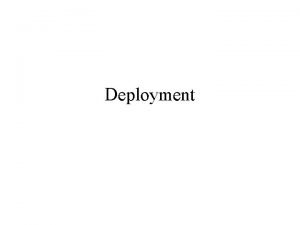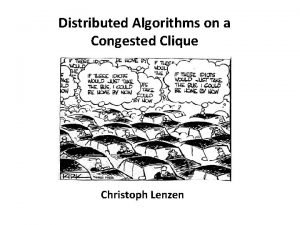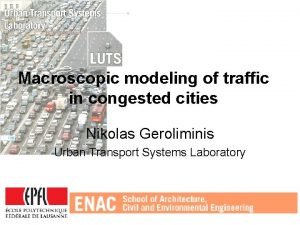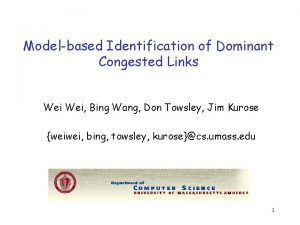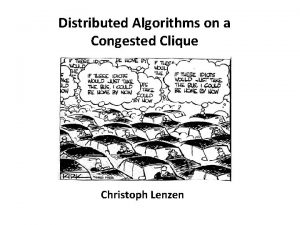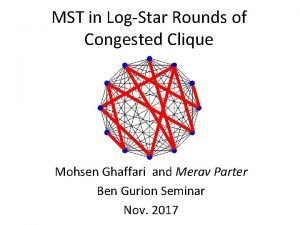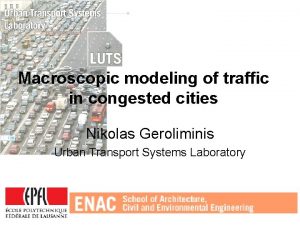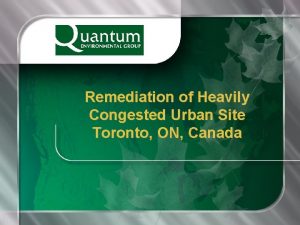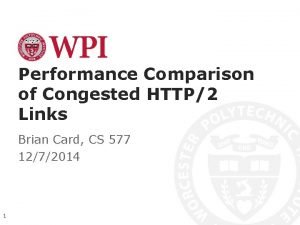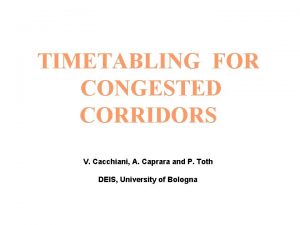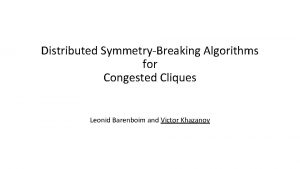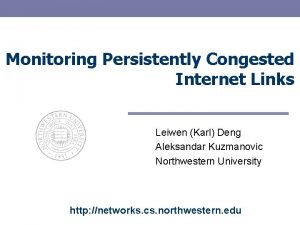Deployment Guidelines for Highly Congested IEEE 802 11




















- Slides: 20

Deployment Guidelines for Highly Congested IEEE 802. 11 b/g Networks Andrea G. Forte and Henning Schulzrinne Columbia University

Background • IEEE 802. 11 b/g networks widely spread • Mostly uncoordinated deployments • Channel assignment not trivial • Our approach – Test on the field (enough optimal algorithms!) – Come out with practical guidelines for network administrators

Wireless Networks • IEEE 802. 11 a – 5 GHz band – 12 non-overlapping channels – Scarcely deployed and used • IEEE 802. 11 b/g – 2. 4 GHz band – 3 non-overlapping channels – Widely spread We focus on IEEE 802. 11 b/g IEEE 802. 11 b

Problems (1/3) Handoff behavior (65 th IETF meeting) • Handoff is triggered – generally, by low signal strength – in congested channel, by frame loss • Effect of layer 2 handoff – Increase of traffic – Disruption of network (0. 5 ~ 1. 5 sec) The number of handoff per hour in each IETF session

Problems (2/3) Handoff behavior (65 th IETF meeting) • Handoffs between channels • Handoff to the same channels : 72% • Handoff to the same AP : 55%

Problems (3/3) Handoff behavior (65 th IETF meeting) • Distribution of session time: • Too often handoff time between handoffs – Disruption of network • 0. 5 ~1. 5 sec per handoff – Increase of traffic due to handoff related frames – probe request and response – 10. 4% of total

Experiments • Experiment 1 – Testing different channel configurations in existing networks • Columbia University campus (site survey) • Experiment 2 – Studying co-channel interference in highly congested scenarios (large number of users) • ORBIT wireless test-bed

Site Survey – Columbia University Google Map!

Site Survey – Columbia University • Found a total of 668 APs – – 338 open APs: 49% 350 secure APs: 51% Best signal: -54 d. Bm Worst signal: -98 d. Bm • Found 365 unique wireless networks – “private” wireless networks (single AP): 340 – “public” networks (not necessarily open): 25 • • • Columbia University: 143 APs Pub. Wi. Fi (Teachers College): 33 APs COWSECURE: 12 APs Columbia University – Law: 11 APs Barnard College: 10 APs

Experiment 1 Experimental setup Sniffer AP Surrounding APs Client Surrounding APs

Experiment 1 – Results (1/3) Using non-overlapping Channels • Throughput and retry rate with no interference Same for any channel • Throughput and retry rate with interference on channel 1

Experiment 1 – Results (2/3) Using non-overlapping Channels • Throughput and retry rate with interference on channel 6 Most congested! • Throughput and retry rate with interference on channel 11

Experiment 1 – Results (3/3) Using Overlapping Channels • Throughput and retry rate with interference on channel 4 Better than channel 6 • Throughput and retry rate with interference on channel 8 Better than channel 6

Experiment 1 Conclusions • Using overlapping channels does not affect performance negatively – In the experiments channel 4 and channel 8 are a much better choice than channel 6 • Use at least channels 1, 4, 8 and 11 (minimum overlapping in band) – better spatial re-use – no significant decrease in performance USE OVERLAPPING CHANNELS!

Experiment 2 Experimental setup • ORBIT wireless test-bed – – Grid of 20 x 20 wireless nodes Used only maximum bit-rate of 11 Mb/s (no ARF) G. 711 CBR Number of clients always exceeding the network capacity (CBR @ 11 Mb/s 10 concurrent calls)

Experiments 2 – Results (1/2) Non-overlapping Channels • AP 1 using Ch. 1 • AP 2 using Ch. 6 • Num. of clients: 43 • AP 1 and AP 2 using Ch. 1 • Num. of clients: 43

Experiments 2 – Results (2/2) Overlapping Channels • AP 1 using Ch. 1 • AP 2 using Ch. 4 • Num. of clients: 67 • AP 1 and AP 2 using Ch. 4 • Num. of clients: 67

Experiment 2 Conclusions • When using two APs on the same channel – Throughput decreases drastically – Physical-error rate and retry rate increase • Using two APs on two overlapping channels performs much better than using the same non-overlapping channel Do not deploy multiple APs on the same nonoverlapping channels USE OVERLAPPING CHANNELS!

One AP vs. many Very high number of users • Network performance with single AP in highly congested scenarios • Network performance with two APs on the same channel in highly congested scenario Using two APs on the same channel performs worst than using a single AP!

Conclusions • Using overlapping channels does not affect performance negatively – Use at least channels 1, 4, 8 and 11 • Do not deploy multiple APs on the same nonoverlapping channels • Using two APs on the same channel performs worst than using a single AP! – Just increasing the number of APs does not help USE OVERLAPPING CHANNELS!
 Bridges from 802.x to 802.y
Bridges from 802.x to 802.y Bridges from 802.x to 802.y
Bridges from 802.x to 802.y Ieee 802 3 compliance
Ieee 802 3 compliance Wlan standards
Wlan standards Arquitetura ieee 802
Arquitetura ieee 802 El 802
El 802 Ieee 802 standard
Ieee 802 standard Ieee 802 bluetooth
Ieee 802 bluetooth 802 ieee
802 ieee Ieee 802
Ieee 802 Ieee 802 family
Ieee 802 family Presentera för publik crossboss
Presentera för publik crossboss Olika rim dikter
Olika rim dikter Formel för lufttryck
Formel för lufttryck Mästar lärling modellen
Mästar lärling modellen Densitet vatten
Densitet vatten Orubbliga rättigheter
Orubbliga rättigheter Jätte råtta
Jätte råtta Smärtskolan kunskap för livet
Smärtskolan kunskap för livet Expektans eller exspektans
Expektans eller exspektans Novell typiska drag
Novell typiska drag





















